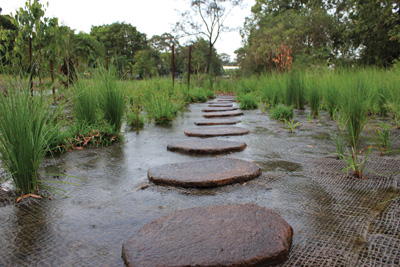A simple, natural stormwater solution in Brisbane, Qld, that doubles as an aesthetic and playful public space.
By Gemma Black
When the skies open above Glindemann Park in Brisbane, rather than retreat for shelter, a few residents have recently been heading outside to watch their newest public asset come to life.

The Glindemann Park Creek Filtration System is the first of eight of its kind to be trialled across Brisbane’s four major catchments as part the Lord Mayor’s Cleaner Waterways Initiative.
Completed in June 2013, the system’s objective was to slow down and filter polluted stormwater flowing from nearby roads, footpaths and residential allotments before it discharges into a tributary of Norman Creek.
Senior Engineer at Brisbane City Council, Mark Gibson, says the council started with a simple directive to “clean the water” in February 2013, and proceeded to engage consultants and stakeholders in roundtable discussions and site meetings over the following months.
“We’ve tried many different approaches in similar projects before, such as gross pollutant traps and bioretention systems,” Gibson says, “but this one is in a slightly different category, as a natural end-of-line system.”
How it works
The design incorporates a rocky ‘scour protection area’ that works to slow down the flow of stormwater and prevent erosion. The water then spreads out over a sandy swale of plants, designed to distribute flow and prevent ponding and mosquitos breeding in the system – a potential problem foreseen and resolved during design stages, Gibson explains. The sand in which the plants grow was specially blended to assist stormwater seepage into the ground, sustain the plants and remove pollutants.
When the swale fills, water overtops a concrete weir that spreads the flow evenly over a densely planted ‘filtering forest’. In the filtering forest, the plants and soil help to further cleanse the stormwater and slow it down so that it more closely mimics pre-development – or non-urbanised – flows. The stormwater and associated nutrients help to sustain and enrich the plants, so watering and fertilising is not required after establishment.
Embankments on either side of the filtering forest keep the stormwater where it’s supposed to flow, and ensure maximum filtration through the forest. They also assist in keeping nearby turfed areas free from ponding water; meaning they remain usable after rainfall.
Community engagement
During the design phase, Brisbane City Council engaged a landscape architect, who incorporated elements to encourage community engagement.
A series of stepping-stones through the filtering forest and signage, for example, help to educate residents and encourage community interaction with the filtration system. Having read the information signs, locals have also been found to visit the system during storms to watch it come to life.
“We’ve received a lot of positive comments about the system,” says Gibson. “People love it.”
Gibson adds that the project is a good example of using a relatively simple, natural system to clean stormwater.
“If you had a big gross pollutant trap at the end of the pipe instead, you’d have a net filled with rubbish, and all the nutrients going straight through anyway,” he says.
“Here, on the other hand, we have quite a beautiful asset that the community loves.”
This article was originally published in the March-April 2014 issue of Public Works Professional